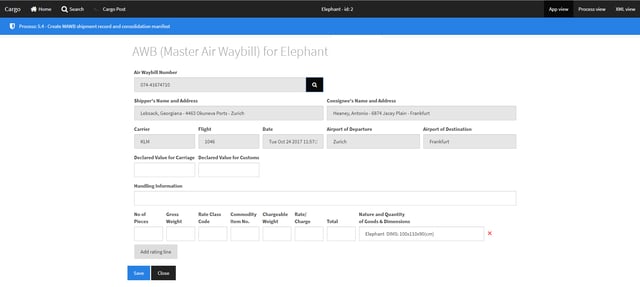This Cargo Handling Training System provides an environment for technical and procedural training of aviation security and the CARGO supply chain as expected by IATA and EU in the context of ACC3 (protected supply chain limited to certified forwarders, carriers and GHAs). Computers get access the LAN or Wireless LAN, enabled through the SkyRadar Cloud Server. The solution in fully integrated into the e-CARGO System. The hold and storage process is triggered by e-CARGO's Flight Data Processing system, process data are seamlessly exchanged between this system and e-CARGO.
This training laboratory helps to train the service, management, operation and optimization of secure supply chains with respect to
SkyRadar's hardware cargo training system has a modern modular and mobile design (on wheels) and consists exclusively of high tech industrial components.
The transfer system is completely modular, consisting of autonomous units, connected via ProfiNet. The overall assembly can be changed and enlarged.
 In the standard configuration is approx. 11 m long and includes the following
In the standard configuration is approx. 11 m long and includes the following
 Bypasses 1 and 2 (Length: 2 m each):
Bypasses 1 and 2 (Length: 2 m each):Industrial Siemens components build the automation system. Those high end components find application in modern airports, due to their MTBF > 10,000 h. S7 PLCs automate the system, Siemens SINAMICs drives control the motors. Siemens SCALANCE security switches provide the firewall and SIMATIC Human Machine Interfaces enable communication with the ProfiNet environment. In addition, the solution includes industrial RFID and Optoelectronic sensors. The components in an overview:
 The Surveillance, Control and Data Acquisition system (SCADA) Siemens WIN CC provides professional analytics and live data from the CARGO Handling System.
The Surveillance, Control and Data Acquisition system (SCADA) Siemens WIN CC provides professional analytics and live data from the CARGO Handling System.
SIMATIC WinCC® is a scalable process visualization system (SCADA) that is graduated by performance, with efficient functions for controlling automated processes. With SIMATIC WinCC, “perfect process visualization“ stands for complete operating and monitoring functionality under Windows for all industry segments – ranging from simple single-user systems through to distributed multi-user systems with redundant servers and the structure of a cross-site solution including Web clients.
Apart from the central computer, 12 students can concurrently access the SCADA system via the SkyRadar CloudServer through the local Ethernet.
SkyRadar e-Cargo (also referred to as "eFreight") is a simulation application based on the IATA e-CARGO standard and the air cargo industry transportation business process (Air Cargo Industry Master Plan) by the Air Cargo iQ Interest Group. Using this tool, you can track the movement of air cargo from the point of booking it with a freight forwarder as a consignor, and ensuring its arrival at the consignee.

To create close-to-real-life dynamics in the landing and departure, you can adjust schedules in real time. For the sake of this application, the FDPS simulator lets you understand the booking and tracking of flights that carry shipments from one destination to another. And it teaches you how to master a dynamic cargo supply chain.
Simulator to create threat awareness and to teach threat detection, prevention and post-attack recovery around the eCargo supply chain.
The objective of these practical exercises is to help teaching system designers, managers and users as well as students to gain the following competences:
The trainer includes
The interactive simulator provides a guided learning invironment. It includes 3 panels:

The cyber attack experiment environment allows to practice within the e-freight route network. It is connected to the Cargo Management and e-Freight (Training) System.

The trainer is equiped with a control panel, an analytics screen as well as attack panels for the teachers to activate threats.
This simulator provides capability for student with image interpretation skills and experience to be able to detect a wide variety of threat items within a restricted time.
The simulator represents a typical graphical user interface of an x-ray scanner with typical functions such as pseudo-colors, grayscale, organic, or metal.

Each application (e-Cargo, cyber security simulation, cyber security experimentor, x-ray simulator) is supplied preinstalled on an industrial rack server.
HPE ProLiant DL20 Generation 9 servers or similar
We provide for all applications the Hewlett Packard HPE ProLiant DL20 Generation9. Only the SCADA & Conveyor system as well as the CloudServer have a different hardware, due to their specific system requirements.
The HPE ProLiant DL20 configuration includes the following:
Hewlett Packard Server HP Prodesk 400 G4 or similar
The SCADA & Conveyor system uses the Hewlett Packard HP Prodesk 400 G4, including:
SkyRadar produces aviation security solutions with industrial components and simulators, allowing for efficient and cost-effective training and qualification.
At the leading edge of security provision within its key markets, Cryptomathic closely supports its global customer base with many multinationals as longstanding clients.
SkyRadar develops innovative radar training solutions and simulation systems, empowering education, research & professional training in aviation and defense sectors.
All rights reserved by SkyRadar 2008 - 2026

CARGO HANDLING SYSTEM - Description | SkyRadar

SkyRadar Consortium
Email: sales@SkyRadar.com | Website: www.SkyRadar.com | © [2026] SkyRadar